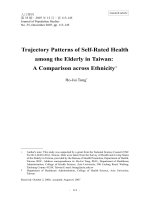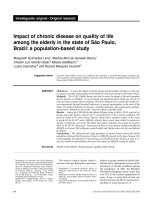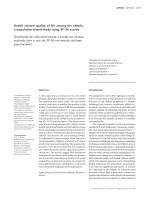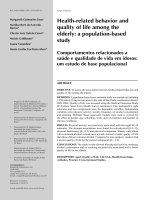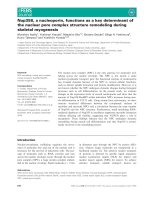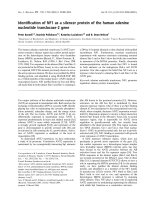Flavor enhancement as a tool for increasing pleasantness and intakeof a snack product among the elderly
Bạn đang xem bản rút gọn của tài liệu. Xem và tải ngay bản đầy đủ của tài liệu tại đây (284.5 KB, 10 trang )
Research Report
Flavor enhancement as a tool for increasing pleasantness and intake
of a snack product among the elderly
S. Koskinen
*
,N.Ka
¨
lvia
¨
inen
1
, H. Tuorila
Department of Food Technology, University of Helsinki, P.O. Box 27, Helsinki 00014, Finland
Accepted 29 April 2003
Abstract
A yogurt-like fermented oat bran product, flavored with regular and heightened concentrations of red currant aroma, was tested in two
tasting sessions (side-by-side) and, between these, in a six-day home-use (monadic testing daily, 3 þ 3 packages of the snack) by the elderly
(n ¼ 50; mean age 73.7, range 63–85 years) and the young (n ¼ 58; mean age 23.1, range 18–34 years). The subjects rated the odor and
flavor intensity and pleasantness and also conducted an odor detection and identification test. In home-use, the subjects reported the quantity
consumed, willingness to eat, buy or recommend the snack. The young outperformed the elderly in the olfactory test. The heightened aroma
samples were initially rated as less pleasant by both age groups, but among the elderly, the ratings given to the two samples merged during
exposure. For the young, the large difference in perceived odor and flavor intensities reflected marked differences in pleasantness, while the
elderly were less responsive to intensity differences in their pleasantness ratings. Overall, both age groups ate less of the heightened aroma
sample. Despite the impaired olfactory capabilities of the elderly, no clear indication of benefit of the enhanced flavor was found for either
pleasantness or intake.
q 2003 Elsevier Ltd. All rights reserved.
Keywords: Elderly; Flavor enhancement; Olfactory test
Introduction
People’s food choices change during the course of aging.
The daily volume of consumed foods and beverages
(grams/day) declines as a function of age. Adjustments in
intake are due to many physiological changes associated
with age, including altered function of smell and taste
(Drewnowski & Shultz, 2001). According to Rolls (1992),
the elderly rate flavor perception as a strong determinant of
their food choices. However, the elderly are often unaware
of their impaired ability to smell and report no decrease in
their appreciation of foods (Wysocki & Pelchat, 1993).
Rolls (1993) suggests that when sensory losses occur
gradually over a period of years, their impact on appetite
also gradually declines.
In the geriatric literature, the term successful aging has
been brought up, and it can refer to any type of function
(Rowe & Kahn, 1987). The term healthy aging is used in
a similar context. Simons, McCallum, Friedlander, and
Simons (2000) suggest that healthy aging is associated with
reduced and delayed disability. Hoffman, Ishii, and Macturk
(1998) reported that individuals’ overall health status, other
sensory impairments, and functional limitations were
associated with an increase in the rate of chemosensory
disorders.
According to Schiffman and Warwick (1993), addition of
flavor can compensate for age-related perceptual losses,
improve food palatability and acceptance, and increase
intake in the elderly. Tuorila, Niskanen, and Maunuksela
(2001) found a slight indication that by adding an
appropriate aroma the hedonic quality of food could be
improved among the elderly. Mattes and Cowart (1994)
proposed that while increasing the appeal of foods by adding
flavor may enhance the quality of life for people who have
suffered chemosensory loss, it would probably have little
nutritional relevance. Griep, Mets, and Massart (2000)
found a clear increase in preference for flavor-enhanced
food in the elderly, but a preference for a particular food
0195-6663/03/$ - see front matter q 2003 Elsevier Ltd. All rights reserved.
doi:10.1016/S0195-6663(03)00054-0
Appetite 41 (2003) 87–96
www.elsevier.com/locate/appet
1
Present address: Seina
¨
joki Polytechnic, Finland.
*
Corresponding author.
E-mail address: sari.ml.koskinen@helsinki.fi (S. Koskinen).
did not necessarily imply increased intake. De Jong,
De Graaf, and van Staveren (1996) studied different sucrose
concentrations in breakfast items and showed that flavor
concentration rated as being most pleasant by the elderly in
a laboratory setting failed to predict pleasantness and food
intake in realistic settings.
Wysocki and Pelchat (1993) suggest that olfactory loss is
not uniform across odorants. Additionally, De Graaf, Polet,
and van Staveren (1994) and De Graaf, van Staveren, and
Burema (1996) reported that differences were present
between age groups in pleasantness ratings of different
types of flavors. According to Murphy (1993), the age
effects on preference do not appear to be related to generally
lower perceived intensity. The overall odor or flavor
complex may be differentially perceived by the elderly
and the young. Thus, when some of the components fall
below an older person’s threshold, the altered flavor may
then drive the preference.
Most preference tests are based on first impressions of
an evaluated product, and thus do not reflect preferences
that result after a longer exposure to the product. The
natural eating environment at home also contributes to
realistic hedonic ratings (Porcherot & Issanchou, 1998).
Moreover, Cardello and Maller (1982) have questioned
the respondent’s ability to form an opinion on the basis
of a very short exposure to a product that is normally
used in larger quantities.
Sensory impairments over the course of aging have
been widely studied, and relatively abundant literature
also exists on the hedonic responses of the elderly
towards foods with enhanced flavor. However, little is
known about the effects of exposure on the hedonic
responses of the elderly towards such foods. In addition,
very few reported studies are available that examine the
relation between olfactory capability and hedonic
responses over time. One such study has been conducted
by Pelchat and Schaefer (2000), who hypothesized that
the age difference in liking a vanilla beverage might be
mediated by different olfactory sensitivity. However, they
found no correlation between odor sensitivity (measured
with phenyl ethyl alcohol, PEA) and liking of the vanilla
beverage at any phase of the study.
The aim of the present study was to examine the effects
of heightened aroma concentration on the pleasantness and
intake of a snack product in elderly and young consumers
over a longer exposure. To obtain additional information on
the effects of olfactory sensitivity and health-related issues
on sensory and hedonic responses, the elderly were sub-
grouped based on their olfactory function and health status.
We hypothesized that the enhancement of flavor by adding
aroma would increase the pleasantness and intake of the
elderly with diminished olfactory capability (De Graaf et al.,
1994, 1996). Furthermore, we anticipated that poor health
status of the elderly would impair their olfactory perform-
ance (Schiffman, 1997) and predict decreased intake (Rolls,
1993; Schiffman, 1994).
Methods
Subjects
A total of 57 elderly and 62 young subjects were initially
recruited, but seven of the former and four of the latter
group missed one of the three test sessions and were
therefore excluded from the data analysis. The indepen-
dently living elderly subjects (n ¼ 50; 38 females and 12
males, mean age 73.7, range 63–85 years) were recruited
from the visitors of four service centers for the elderly in
Helsinki by personal contacts. The young subjects (n ¼ 58;
55 females and 3 males, mean age 23.1, range 18–34 years)
were recruited from the staff and students of the University
of Helsinki by announcements. The study was conducted
according to the general principles of sensory testing in our
laboratory, which have been approved by the ethical
committee of the faculty. The subjects signed an informed
consent before the study began. The subjects participated in
two evaluation sessions lasting approximately 30 min each.
In addition to the tasting sessions, the subjects participated
in a six-day home-use test. Subjects received a small food
reward after the last evaluation session.
Samples
The sample material was a fermented oat bran product
(Yosa
w
, Bioferme, Finland), which is a cereal-based snack
food similar to flavored yogurt. Samples were flavored with
a 20% (w/w) red berry jam (Valio Ltd, Finland), containing
strawberry, red currant, lingonberry, and chokeberry. Two
concentrations of red currant aroma (Valio Ltd, Finland)
were also added to the samples. The aroma concentrations
(regular 0.02% and heightened 0.78%) were selected after
pre-testing by an experienced laboratory panel (n ¼ 10; 7
females, 3 males, aged 25–41 years), which evaluated the
odor (by sniffing) and flavor intensity (by tasting) of five
concentrations of red currant aroma in the oat bran product.
The two selected concentrations differed from each other
significantly in odor and flavor intensities (means: 3.8 vs.
7.1 for odor and 3.5 vs. 7.4 for flavor on a 9-point scale).
A sensory profile of the two snack product samples was
created by a laboratory panel (n ¼ 9; 7 females, 2 males,
aged 25 –41 years) trained to evaluate attributes selected in
advance. The attributes were evaluated on a 9-point scale
that was anchored from 1 ¼ weak to 9 ¼ strong. The
heightened aroma sample was perceived as more intense in
currant odor and total odor, but less intense in strawberry
odor. It was also perceived to be less sweet, more bitter and
more intense in currant flavor and in overall flavor, and
stronger in after-taste than the sample with a regular aroma
concentration. The heightened aroma concentration caused
a slight off-flavor described as ‘artificial’.
The manufacturer packaged the samples in 150 ml white
plastic cups, which were coated with yellow cardboard and
sealed with white aluminum lids. The packaging was similar
S. Koskinen et al. / Appetite 41 (2003) 87–9688
to the commercial version, except for being blank. The
samples were stored refrigerated at 4 8C.
Tasting sessions
The tasting sessions for the young subjects were
conducted in the sensory laboratory at the University of
Helsinki, and for the elderly in the dining rooms or
clubrooms of the service centers. Tests were conducted
before and after a six-day home-use period. The subjects
received two samples of the snack product successively in
both sessions and were asked to rate the odor intensity (by
sniffing) and flavor intensity (by tasting) of the samples
using a 9-point intensity scale that was anchored from
1 ¼ weak to 9 ¼ strong. Overall pleasantness of the
samples was rated on a 9-point hedonic scale, anchored
from 1 ¼ do not like at all to 9 ¼ like very much. The odor
intensity was rated right after opening the lid, and the
pleasantness and flavor intensity after tasting 3–4 spoonfuls
of the sample. The serving temperature of the samples was
4–6 8C. Subjects rinsed their mouths with tap water before
tasting the samples and between samples. The samples were
coded with three-digit random numbers, and their presen-
tation order was individually randomized for each subject.
Before evaluating the samples in the first tasting session,
the subjects filled in a background questionnaire covering
their demographic background and nutritionally related
diseases (Table 1). Furthermore, the subjects reported their
familiarity and liking of the target product, as well as those
of yogurt and porridge. Since no main or interaction effects
of those variables were found on any of the ratings, the data
on familiarity and liking are not reported here. The lack of
effect of familiarity and liking of the target product on the
ratings was probably due to its resemblance to yogurt.
Home-use test
For the home-use test, subjects received three cups
(150 g each) of the snack product at regular aroma
concentration and three cups at heightened aroma concen-
tration and were instructed to refrigerate them. The samples
were coded with numbers 1–6, indicating the eating order
of the samples. Half of the subjects ate the regular aroma
samples first and half ate the heightened aroma samples first.
The subjects were asked to rate one sample a day at any time
of the day they wanted. Similarly to the tasting sessions,
the odor intensity was rated right after opening the lid, and
the pleasantness and flavor intensity after tasting 3–4
spoonfuls of the sample. The scales used were the same as in
the tasting sessions. Subjects were also asked to evaluate the
amount of eaten snack product using a 5-point visual scale
with simple boxes black and white in color, the black part
indicating the amount of left-over in the cup after eating. In
data treatment, the visual scale points were converted into
rough percentages: 0 (sample tasted only), 25, 50, 75 and
100% consumed of the total amount. The subjects were also
asked to mark the time and meal context in which they ate it.
The data on the eating context and time are not reported
here. After the third and sixth days, subjects rated separately
their boredom with and willingness to eat and buy the
product and recommend it to their friends on a 9-point scale,
anchored from 1 ¼ not willing/bored at all to 9 ¼ very
willing/bored.
Originally the subjects (young and elderly separated)
were divided into three groups, which were given different
information on the samples for the home-use. One group in
both age cohorts was informed about the organic quality of
the sample and another group received information about
the sample’s healthiness and low fat content. A third group
served as control, receiving no additional information,
except for the list of ingredients. The written information
was provided on the front page of the home-use booklet.
Preliminary data analysis revealed no significant main
effects and only one significant interaction of day and aroma
on the pleasantness ratings of the young, implicating an
increase in pleasantness of the heightened aroma sample in
the presence of health-related information. Since the effects
of information were negligible, and not relevant enough for
this study, the data were pooled together over the
information conditions.
Olfactory test
As the final task in the second tasting session, most of the
subjects (53 young, 39 elderly) participated in a test that
measured their olfactory performance, the European Test of
Olfactory Capabilities (ETOC). The test consists of 16
common food and non-food odors that were presented to the
subjects in 16 series of four vials: three of the vials were
blanks and one contained the odor stimulus. Subjects were
asked first to detect which of the four vials contained the
odor (detection). After detection, the subjects were
Table 1
Total number, gender distribution, age distribution, mean age, and nutritionally related diseases of the subjects
Age group Characteristics
Total number Gender
(male/female)
Age range
(years)
Mean age
(years)
High blood pressure
ðnÞ
High cholesterol
ðnÞ
Diabetes
ðnÞ
No diseases
ðnÞ
Young 58 3/55 18– 34 23.1 2 0 0 56
Elderly 50 12/38 63– 85 73.7 20 13 7 20
S. Koskinen et al. / Appetite 41 (2003) 87–96 89
presented a list of four possible odors and asked to select the
one they thought was correct (identification) (for more
information on the test, see (Thomas-Danguin et al.,
2003a)).
Data analysis
Repeated measures analysis of variance was used to test
the within-subject effect of aroma concentration of the
sample (two levels) and the day of eating (three levels) on
sensory and hedonic ratings and intake ratings in home-use.
Age group (two levels) was used as a between-subject factor.
The boredom ratings and the willingness ratings to eat, buy,
and recommend were tested using aroma (two levels) and day
(two levels, third and sixth day) as within-subject factors and
age group (two levels) as a between-subject factor. In the
tasting sessions, the within-subject effects tested were aroma
concentration of the sample (two levels) and the session (two
levels, before and after the home-use). Age group (two
levels) was used as a between-subject factor. These statistical
analyses were also conducted with gender as a between-
factor to examine its effect. No trend towards the main effect
or interaction of gender was found, and therefore, the effect
of gender was not treated in results.
The data of the olfactory test (ETOC) were analyzed with
one-way analysis of variance, comparing the detection and
identification scores of the young and the elderly. The effect
of gender was examined in the group of the elderly with
one-way analysis of variance. The olfactory scores were
compared with the mean scores of age-matched sub-groups
in data on 1100 subjects using paired t-test. Furthermore, the
elderly were divided into two subgroups based on their
identification scores in ETOC using a score of 10 as a cut-off
point: (subgroups: identification score 0 –10 and 11 –16).
With this cut-off point we could expect differences in
perceived odor and flavor intensities (Tuorila & Koskinen,
2003). These two subgroups were referred to as ‘low score’
and ‘high score’, respectively. Next, the effect of perform-
ance in the odor identification test on hedonic ratings and
intake was tested using repeated measures analysis of
variance (within aroma, between identification score). The
odor identification scores of the young were not subdivided
because of their low variation.
The elderly were also divided into two subgroups based
on the number of nutritionally related diseases they had.
These subgroups were designated ‘good health’ (one or no
diseases) and ‘poor health’ (two or more diseases). The
difference between these groups in odor detection and
identification scores and intake was tested with one-way
analysis of variance.
The variation in the within-groups degrees of freedom
associated with F-values is due to some missing values in
the data of the elderly. In the case of intake, there was also
missing data from the young. The number of subjects used
in analyses of the intakes was 53 (out of 58) for the young
and 42 (out of 50) for the elderly.
Results
Tasting sessions
Sensory ratings
Both age groups rated odor intensity as stronger in the
heightened aroma sample (Fð1; 106Þ¼139:48; p # 0:001).
However, the young perceived a larger difference in odor
intensity between the samples than the elderly (interaction
of age group and aroma, Fð1; 106Þ¼13:84; p ¼ 0:007).
The young tended to rate the odor as more intense than the
elderly (Fð1; 106Þ¼3:67; p ¼ 0:058). No significant differ-
ence was present in odor intensity ratings between the two
tasting sessions. The ratings of flavor intensity were very
similar to those of odor intensity. Both age groups rated
flavor intensity as stronger in the heightened aroma sample
(Fð1; 105Þ¼77:90; p # 0:001). The young perceived a
larger difference in flavor intensity between samples than
the elderly (interaction of age group and aroma,
Fð1; 105Þ¼8:50, p ¼ 0:004). The flavor intensity ratings
did not differ significantly between the first and second
tasting sessions or between age groups.
Hedonic ratings
In the pleasantness ratings, the aroma concentration had a
similar effect on both age groups in the first tasting session:
the heightened aroma sample was rated as less pleasant than
the regular aroma sample (Fð1; 106Þ¼54:90; p # 0:001).
However, the difference between the pleasantness ratings of
the two samples was smaller for the elderly than for the
young (interaction of age group and aroma, Fð1; 106Þ¼
19:55; p # 0:001). A change in the pleasantness ratings of
the two age groups between the samples occurred from the
first tasting session compared with the second one (Fig. 1).
According to the young, the pleasantness ratings of the
regular aroma sample were almost the same in both tasting
sessions, while the pleasantness ratings of the heightened
Fig. 1. Mean pleasantness ratings (þSEM) of the young ðn ¼ 58Þ and the
elderly ðn ¼ 50Þ given to regular and heightened aroma samples in the
tasting sessions.
, regular aroma; B, heightened aroma.
S. Koskinen et al. / Appetite 41 (2003) 87–9690
aroma sample decreased in the second tasting session
compared with the first session. Among the elderly, the
regular aroma sample was perceived to be slightly less
pleasant in the second tasting session than in the first one,
whereas the pleasantness of the heightened aroma sample
increased in the second tasting session compared with the
first one (interaction of age group and aroma and tasting,
Fð1; 106Þ¼10:41; p ¼ 0:002).
Home-use test
Sensory ratings
In home-use, the odor and flavor intensity ratings were
affected by aroma concentration but not by age group. The
odor intensity (Fð1; 106Þ¼13:95; p # 0:001) and flavor
intensity (Fð1; 103Þ¼14:79; p # 0:001) of the heightened
aroma sample were perceived as stronger in both age
groups. Compared to the side-by-side tasting, both age
groups rated less difference in odor and flavor intensity
between the samples in the home-use (monadic testing).
(Fig. 2a–d).
Hedonic ratings
The heightened aroma concentration decreased plea-
santness ratings of both age groups also in home-use
(Fð1; 105Þ¼21:48; p # 0:001). Again, the difference
between the pleasantness ratings of the two samples
was smaller for the elderly than for the young
(interaction of age group and aroma, Fð1; 105Þ¼5:23;
p ¼ 0:024). The pleasantness of the heightened aroma
sample increased during the home-use, while the
pleasantness of the regular aroma sample remained
virtually unchanged (interaction of aroma and day,
Fð2; 210Þ¼6:12; p ¼ 0:003) (Fig. 2e– f).
Fig. 2. (a –f) Mean odor intensity ratings (þ SEM); (a– b), flavor intensity ratings (þSEM) (c–d), and pleasantness ratings (þ SEM) (e–f) of the young
ðn ¼ 58Þ on the left (fig. a,c,e) and the elderly ðn ¼ 50Þ on the right (fig. b,d,f) given to the regular and heightened aroma samples in the tasting sessions and
during home-use.
, regular aroma; , heightened aroma.
S. Koskinen et al. / Appetite 41 (2003) 87–96 91



